Next Time you Process Cattle, Pull Tail Hairs
DNA Sampling and Application in the Cow Herd
This is a guest post written by Sean McGrath, a rancher and consultant from Vermilion, AB.
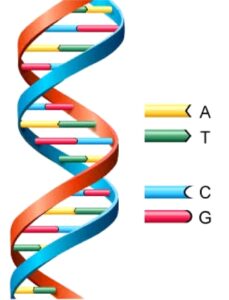
DNA is the genetic code that determines how an animal grows, performs and interacts with its environment. Every animal inherits DNA from its parents with ½ coming from the maternal side and ½ from the sire. The building blocks of DNA are four base pairs: Adenine (A), Thymine (T), Guanine (G) and Cystosine (C). DNA is arranged in long ‘double strings’ in which A and T are paired and C and G are paired. A ‘gene’ is an area of this double string that codes for a specific function in the animal. By substituting one or more base pairs in the gene (i.e.: replacing an AT pair with a GC pair) a different function may be expressed in the animal (i.e.: red coat colour vs. black).
Technology to examine DNA in cattle has been around for several years, however in the past it has been cost prohibitive. Newer technology called SNP (pronounced “snip”) has changed much of this and made DNA testing a viable option for beef producers, even at commercial industry levels. SNP technology looks for changes in base pairs along the string of DNA. It does not look for specific genes, but rather examines areas that may be ‘associated’ with or close to regions of DNA that code for specific proteins or functions. The advantage of SNP technology over previous tools is that it allows us to examine many more pieces of DNA at a low cost.
SNP technology may be used in several different ways including parentage determination, traceability, trait assessment, genetic defect testing, enhancing accuracy of genetic evaluations and sorting cattle into management groups. (Links to the main Canadian labs: http://genetix.quantumgenetix.com/ and http://www.deltagenomics.com/)
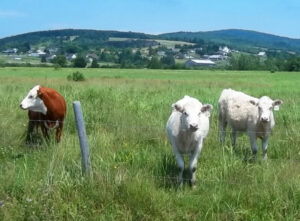
Because various breeds are the result of differences in their DNA, some tests may be breed specific or be more effective in one population than another. It is important to check if any available test is specific to the breed or crossbreed in question.
Most producers will not want to jump right into parentage or testing for various traits, however collection and storage of DNA on your herd can be a valuable management tool at a relatively low cost. Having DNA samples readily available allows you to easily access the technology at the time and level you feel is appropriate. Some feedlots are now requesting cattle that fit specific genotypes, so it might be worth having your cattle’s DNA samples on hand so that you can be an eligible supplier. Another example: if you have calving problems, it will be possible to rapidly assess whether the problem is with a specific sire or a more general management problem involving cattle from several sires. Collection and storage of DNA samples is an inexpensive way to prepare for these types of scenarios.
It is useful when collecting samples to collect them early in an animal’s life and at a convenient time such as during regular processing. Collecting new sires as they are delivered to the farm, or replacement heifers as they are selected for the cowherd is a good practice. If an animal dies or is disposed of such as a cull bull that you may want to test, you cannot retroactively collect samples. As well, in the event that you want to use testing for serious issues such as calving difficulties or genetic defects you do not want to have to run the entire sire battery or cowherd through the chute in the middle of a busy period.
Since every tissue in the animal contains DNA, options for DNA samples include tissue, blood and hair. Hair is the easiest and cheapest to collect and store, as the DNA in the root bulb of the hair decays very slowly. Tissue samples, which contain a higher quantity of DNA than hair samples, must be collected and stored using specialized containers with preservatives or be frozen in order to prevent the DNA from breaking down, but they work well if you are testing right away. For long term storage, hair can be placed in a paper envelope labeled with the animal’s tag and stored in a dry and dark location such as a filing cabinet.
How to collect tail hairs for DNA sampling
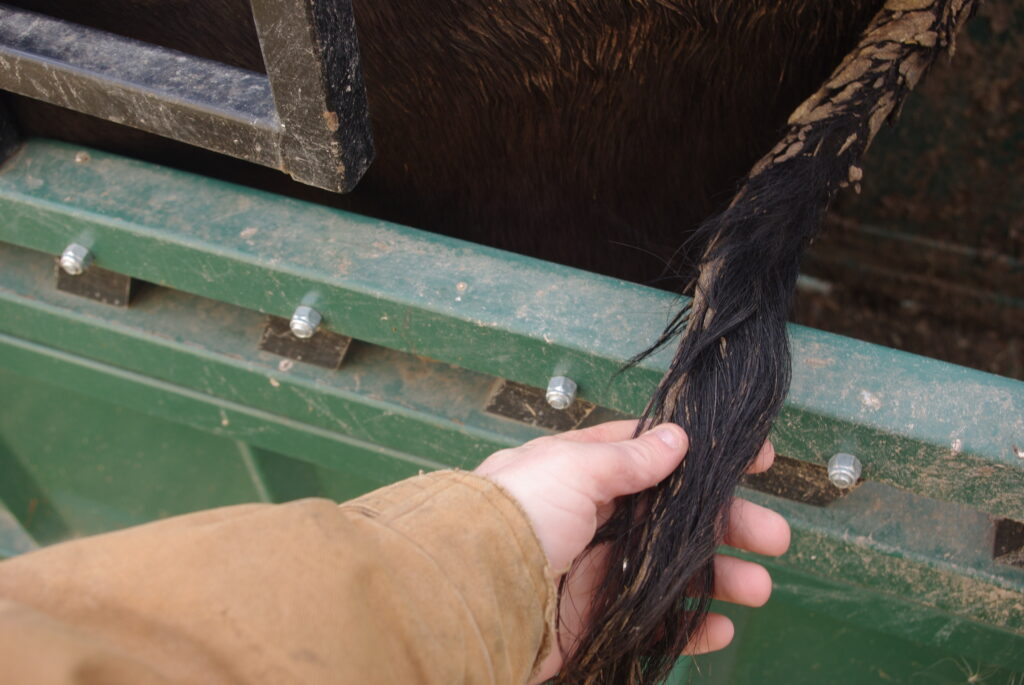
Tail hairs should be pulled (not clipped) from the animal’s tail switch
- 20 hairs will provide enough sample for basic parentage testing
- 40-50 hairs will provide enough DNA material to conduct a variety of tests in the future (Note: some breed associations require 60 hairs)
Ensure the sample includes the root bulbs as this is where the DNA is located
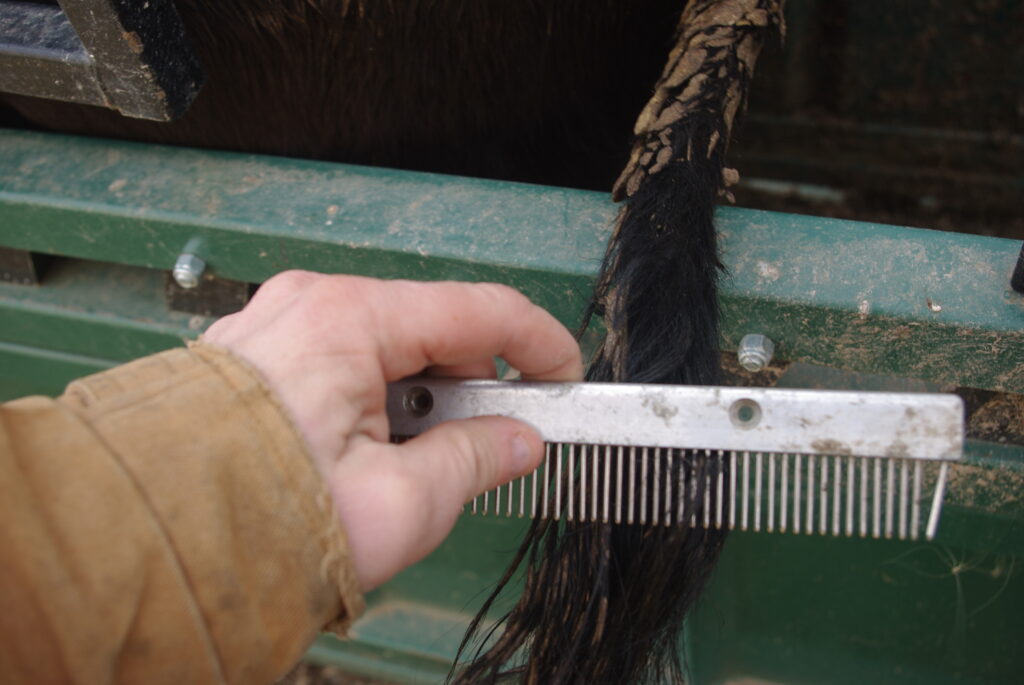
- Use a separate paper envelope for each animal
Collection/Testing Strategies

The more samples collected, the more testing options will be readily available in the future. Each operation will need to decide what animals should have DNA samples on file. Collecting replacements each year will eventually provide DNA samples for the entire cowherd. The points below can help you to decide what level of collection is the best fit for your operation.
Bulls
Lower number of animals / Less testing cost
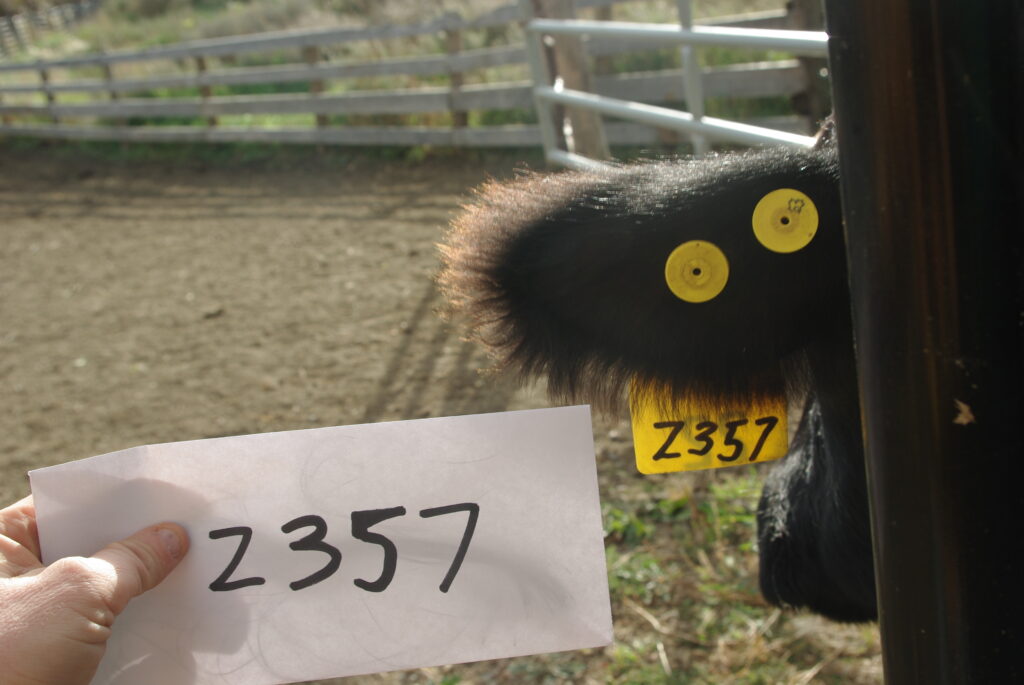
Cows
- Large number of animals
- Remain in herd for a long time frame
- ½ the calf crop DNA
- May consider collecting/testing replacements as they enter the cowherd to eventually end up with the entire cowherd being completed
Calves
 Large number of animals
Large number of animals- May consider testing at lower levels (i.e.: parentage only)
- May consider testing specific samples (i.e.: replacement heifers, chronic illness, calving difficulties)
Where to send your samples for parentage testing
- Neogen Canada
- Learn more on how to optimize your herd genetics with Neogen Canada, Livestock Gentec and AAFC.
- Quantum, located in Saskatoon, SK
Summary
- DNA technology is rapidly changing and costs are decreasing
- A variety of DNA tests are available at various price levels
- DNA tests may be breed specific
- DNA sample collection using hair can be a low cost way to prepare to use this technology
- Hair samples can be collected from the animal’s tail switch and should:
- Be clean and dry
- Contain at least 40 to 50 hairs
- Contain root bulbs from the hair
- Hair samples can be stored in labelled paper envelopes in dry/dark location such as a filing cabinet
- Bulls offer a lower cost/higher impact method to start testing
- Collecting samples on replacements will allow for a full set of DNA samples on the herd over time
- Smaller groups such as replacement heifers may be tested over time to eventually have the entire herd tested
Click here to subscribe to the BCRC Blog and receive email notifications when new content is posted.
The sharing or reprinting of BCRC Blog articles is welcome and encouraged, however because this article was written by a guest contributor of the BCRC Blog, it requires permission of both the BCRC and the original author.
We welcome your questions, comments and suggestions. Contact us directly at info@beefresearch.ca or generate public discussion by posting your thoughts below.